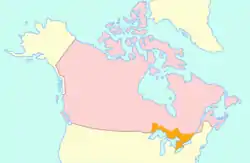Upper Canada
Upper Canada is an old British name for the Canadian province of Ontario.
Province of Upper Canada | |||||||||
|---|---|---|---|---|---|---|---|---|---|
| 1791–1841 | |||||||||
 Flag | |||||||||
 Map of Upper Canada (in orange) with 21st-century Canada (in pink) surrounding it | |||||||||
| Status | British colony | ||||||||
| Capital | Newark 1792–1797 (renamed Niagara 1798, Niagara-on-the-Lake 1970) York (later renamed Toronto in 1834) 1797–1841 | ||||||||
| Common languages | English | ||||||||
| Government | Family Compact oligarchy under a Constitutional monarchy | ||||||||
| Sovereign | |||||||||
• 1791–1820 | George III | ||||||||
• 1820–1830 | George IV | ||||||||
• 1830–1837 | William IV | ||||||||
• 1837–1841 | Victoria | ||||||||
| Lieutenant-Governor; Executive Council of Upper Canada | |||||||||
| Legislature | Parliament of Upper Canada | ||||||||
| Legislative Council | |||||||||
| Legislative Assembly | |||||||||
| Historical era | British Era | ||||||||
| 26 December 1791 | |||||||||
• Act of Union 1840 | 10 February 1841 | ||||||||
| Area | |||||||||
| 1836[1] | 258,999 km2 (100,000 sq mi) | ||||||||
| Population | |||||||||
• 1823[1] | 150196 | ||||||||
• 1836[1] | 358187 | ||||||||
| Currency | Halifax pound | ||||||||
| |||||||||
| Today part of | |||||||||
References
- Butler (1843), pp. 10, 20
This article is issued from Wikipedia. The text is licensed under Creative Commons - Attribution - Sharealike. Additional terms may apply for the media files.